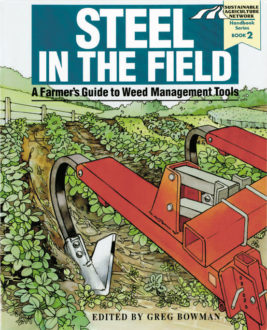
Agronomic Row Crops: The Farmers
Steel, Flames Beat Back Weeds in Delta Cotton
Steve McKaskle
Kennett, Missouri
- 1,100 acres (600 farmed organically)
- sandy loam soil, Mississippi delta
- crops: cotton, soybeans, spelt
- covers: grain rye, hairy vetch, buckwheat
Weed management highlights
Strategies: crop rotation... composting and cover crops to improve soil quality... aggressive mechanical weed control... manual hoeing
Tools: 'do-all' combination tool... standard rotary hoe... no-till cultivators.. flamer
As a pioneer in managing cotton weeds without herbicides, Steve McKaskle quickly learned that change was going to be a central part of his management plan. Since '90 he has adopted new farming styles, crops and even colors of cotton in his quest for greater sustainability in the 'far north' of the Mississippi Delta cotton country, just across the river from northern Tennessee.
McKaskle focuses on lowering weed competition at planting in his successful but evolving herbicide-free system. He uses organic methods on 600 of his 1,100 acres, relying heavily on tillage then flaming to manage weeds during the season.
His weed containment for the next year starts even before the current year's crop is harvested. Before leaf drop in cotton and soybeans, he seeds a grain/legume cover-crop mix at 63 pounds per acre (18 pounds of hairy vetch, 45 pounds of rye) from an airplane. 'Having the seed mixed in a fertilizer blender and trucked directly to the airport is the secret to making this work,' reports McKaskle.
He figures his air-seeding cost at about $4 per acre, considerably less than planting and disking passes by tractor. Falling leaves cover the seeds to create a moisture-holding mulch that enhances germination for a winter-long, weed-smothering, green carpet.
He gets an even earlier start for the coming year where he harvests winter grain crops of spelt or wheat in early summer. He immediately incorporates residue with two or three successive diskings, then uses summer-fallow tillage to attack weed patches. His fallow tool of choice is a Triple K. The high-speed tool features four ranks of 18-inch S-tine cultivator shanks outfitted with 4-inch sweeps ahead of rolling basket harrows. He runs it 2 to 3 inches deep at 6 to 7 mph before weeds reach 4 inches tall.
He avoids anything but shallow treatments until the following spring to conserve moisture. McKaskle makes an exception in areas infested with Bermudagrass. There he uses a chisel plow with 8-inch sweeps to expose the grass's roots to wind and intense summer sunlight. In persistent spots, he'll make a final run just before he expects a killing frost. The fallowed fields may handle an August buckwheat smother crop (drilled in 7-inch rows) that's harvested in October before receiving an overwintering rye/vetch or wheat/vetch mix seeded from the air.
By early April, the vetch is usually 12 to 18 inches tall, but biomass amounts vary with the winter weather. 'Growth was thick as a hedge' after a mild winter in '95, but was thin in '96 due to cold temperatures, McKaskle reports.
Because of the importance of beds to hasten soil warming and retain deep moisture through the season, he goes through a series of tillage steps between winter cover and summer planting.
He incorporates the biomass by moldboard plowing 6 to 8 inches deep, then disking. A disk bedder is his tool of choice to create 38-inch wide beds that he then subsoils exactly where tap roots will need water. To do this, a 'ripper/hipper' creates a shaft of loosened soil as it reshapes raised beds and prepares a flat seedbed to capture rainfall.
McKaskle's soil warms more slowly than the soil farther south, where much more cotton is grown. He waits for a predicted run of warm nights when soil temperature is 60 o F to 65 oF - usually two to three weeks later than neighboring farmers plant. His goal is to have germination within five days, giving his cotton a jump on weeds and a vigorous, competitive nature.
Cotton growers face a weed threat for about three months, compared with the six weeks it takes for Midwestern soybeans to canopy in 30-inch rows or for Midwestern corn to reach lay by (the point at which stalk height prevents further cultivation). This long period in his no-chemical program means McKaskle's post-plant tool treatments are critical to the crop's success.
The moment cotton plants reach 2 inches tall, McKaskle begins the first of two or three rotary hoeings. He starts with maximum down pressure on his standard rotary hoe - two springs hooked on his eight-row John Deere, 22-foot folding unit - releasing one of the springs if too many cotton plants are being plucked out. Crop roots are 2 to 3 inches long at this stage. To get the most out of the tool, he replaces hoe wheels that run on the beds each year. He operates the hoe about 2 inches deep at 6 to 7 mph.
McKaskle makes at least two rotary hoe passes, switching directions each time. These early runs are important to keep morning-glory, cocklebur, yellow nutsedge, teaweed (prickly sida or Sida spinosa) and 'prickly careless weed' (Amaranthus spinosus) in check.
Soon after the crop is 3 inches tall, McKaskle's most accurate tractor driver begins cultivating at 2 to 3 mph. One of the last IH conventional low-residue cultivators made, McKaskle's unit came with five curved, spring-loaded shanks per row. He replaces the shanks next to the row with round standards. These he retools and adjusts to suit each phase of cotton weeding. He runs overlapping 10-inch, medium-profile sweeps in the row middles. The slight elevation in the center of the sweep mixes in more residue than would a low-profile sweep.
'We've run delta (vegetable) knives within two inches of the row, but I want to set disk hillers even closer,' he says. He anticipated a bed-hugging mechanical guidance system he planned to add in '97 would make such an unforgiving margin possible. The knives have a thin vertical fin next to the row and a slim trailing arm that extends into the inter-row area.
'The disks can shave closer to the rows, and cut up vines better than the knives,' McKaskle explains. He also wants a tool to work later in the season. It needs to have a positive slicing action that can knock out 2-feet-tall escaped weeds which the sweeps can't reach without damaging cotton roots.
Thanks to his crop rotation, cover crops and liberal use of composted cotton-gin trash, the sandy soil in his organic fields is loose but has a good tilthy softness from the added organic matter. Sweeps and knives pass cleanly through soil close to the crop without disrupting the plants in the 'drill' (row area). Small weeds are easily dislodged and their roots exposed to the deadly drying effects of sun and wind.
When cotton reaches 6 inches to a foot tall, the operator increases speed and adjusts tooling to start 'dirting the row,' or throwing soil around the base of the plants. Weekly cultivations continue as long as needed, complemented by one comprehensive hand-hoeing after first cultivation and usually one quick walk-through to cut out final escapes.
In 1995, McKaskle figures he spent from 1.5 to 3 times as much ($50 to $75 per acre) for hand-hoeing in his organic cotton as in his conventional field, but still netted at least $100 more per acre, thanks to savings on other inputs and organic market premiums. He wants to test weed thresholds by species on his farm. Results will show if he can tolerate higher numbers of less-competitive weeds, or ones that do not quickly go to seed.
When cotton is 18 inches tall, McKaskle begins to use a standard toolbar flame weeder to manage in-row weeds. He attaches a 200-gallon, highway-certified propane tank to an old preemerge spray rig equipped with foot slides on angling runners. Two vaporizing burners per row fixed at 4 to 6 inches above the ground are angled to direct flame across the row area, one from each side. The burners are staggered so the flames don't collide and thrust upward into the plant. 'You've got to have the flame going through the row to get a clean kill,' he explains. 'Keep the soil smooth so the flames don't bounce up into the crop.'
At about $4 per acre, the flamer creates an efficient - if noisy - way to zap late-season weeds without tillage. (See 'Hot Tips for Flame Weeding') This type of flaming is a local pre-herbicide tradition that many conventional cotton growers are reviving to cut costs, save labor and master their toughest weeds, such as morning-glory. 'Nothing is as effective as flaming once cotton is two feet tall,' he explains.
With a minimum of new tools and skillful use of existing ones, McKaskle is dedicated to refining his integrated weed management system of cover crops, steel and flame. He wants more precise tractor driving to take out weeds closer and faster, and better flaming management to extend its use. Those changes should help him toward his long-term goals to reduce tillage passes and suppress in-row weeds even better.
